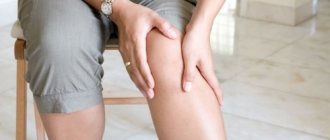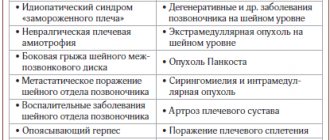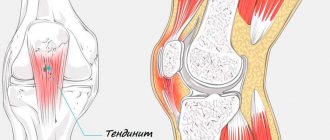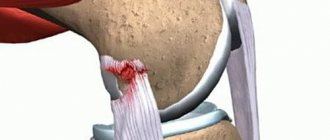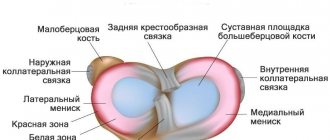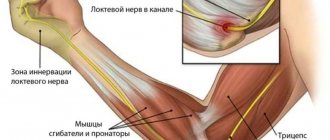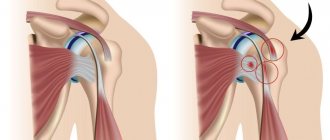Main reasons
The main causes of inflammation of the soft tissues located around the knee include:
- general or local hypothermia;
- intense loads on the joint;
- acute and chronic infectious diseases;
- injuries of bone, cartilage or soft tissue, as well as ligamentous apparatus;
- degenerative-dystrophic processes in the knee area;
- lack of adequate physical activity and physical inactivity;
- congenital defects of the ligamentous apparatus;
- chronic diseases of the bone and cartilage tissues of the knee joint: arthrosis, arthritis, osteochondrosis, osteoporosis, etc.
The risk of periarthritis increases:
- poor blood circulation in the lower extremities;
- atherosclerosis;
- excess body weight;
- type 1 and type 2 diabetes;
- hormonal imbalance;
- spasms in small and large vessels;
- increased blood viscosity;
- pathologies of the endocrine system.
The likelihood of periarthritis increases in professional athletes and young people whose work activities involve intense physical activity. Also at risk are patients who have undergone surgery on the lower extremities. During the rehabilitation period, they may develop inflammation of the soft tissues or ligaments surrounding the knee joint.
What is periarthritis of the knee joint?
Periarthritis of the knee joint is an inflammation of the tissues that surround it.
The disease is accompanied by degenerative changes. They involve muscle fibers, ligaments, tendons, and synovial bursae. They suffer from dystrophy, which results in reactive inflammation. According to statistics, about 10% of people experience periarthritis of the knee joint. Women aged 55 years and older are most often affected. Although sometimes this diagnosis is given even to children. Their joint tissues become inflamed during periods of active growth.
Signs
Symptoms of periarthritis are nonspecific and similar to signs of arthrosis, osteoarthritis and other pathologies, therefore, when diagnosing pathology, you should pay attention to the patient’s age and gender. Inflammatory processes in soft tissues more often occur in women after 40 years of age. In men, periarthritis is diagnosed much less frequently.
The characteristic signs of the disease, which make it possible not to confuse it with arthritis and osteoarthritis, include acute pain. In most patients, it is localized in the area of the connection of the medial condyle of the tibia with the semimembranosus, semitendinosus and sartorius muscles.
The pain in the inner part of the knee at rest is dull and aching. It worsens with any load on the knee area: doing exercises, climbing stairs, walking at a fast pace. Later, the pain syndrome intensifies even when turning from back to side and throwing back the leg, as well as when palpating the inflamed area.
In a neglected state, the following is added to the constant pain:
- swelling;
- swelling;
- redness of the skin;
- low-grade fever.
In acute inflammation, the patient experiences symptoms of general intoxication of the body: weakness, loss of appetite, dizziness, nausea, headaches. In an advanced state, soft tissue necrosis occurs. Dead ligaments and tendons become scarred. Calcium salts are deposited in the periarticular tissues, which limit the mobility of the knee. Later, mineral deposits cause its atrophy, complete immobility and disability.
Clinical picture of the disease
Under the influence of pathological factors, tendon tissues become inflamed, and foci of necrosis form in them. Subsequently, the connective fibers become denser, grow (cell sclerosis and fibrosis), and calcify.
The clinical picture of knee periarthritis is determined by the stage of its development. If at the initial stage the pain is barely noticeable and only bothers you during moments of overload, then as the pathology progresses, it becomes acute. Sometimes a person completely loses the ability to move normally.
In the vast majority of cases, the tendons of the semitendinosus and semimembranosus muscles at their attachment points become inflamed. The pain occurs when walking, when trying to bend the leg, and when standing for long periods of time. Palpation of the affected area allows you to identify characteristic painful points. Sometimes there is noticeable redness and swelling of the skin.
Treatment of acute periarthritis
Acute periarthritis is treated with medication: non-steroidal anti-inflammatory drugs for internal and external use, analgesics. Medicines can be supplemented with physiotherapeutic procedures.
Tablets and ointments for periarthritis
The main NSAIDs for periarthritis for internal use include:
- Movalis;
- Nimulid;
- Dicloberl;
- Ibuprom;
- Nurofen;
- Ketonal.
Non-steroidal anti-inflammatory ointments are also recommended:
- Diklak;
- Voltaren emulgel;
- Lyoton;
- Nimid.
Pain syndrome is relieved by analgesics:
- Analgin;
- Paracetamol;
- Solpadeine;
- Tylenol;
- Novalgin.
Painkillers are supplemented with complexes with B vitamins. For severe inflammation, glucocorticosteroid tablets or injections are prescribed: Diprospan, Kenagol, Hydrocortisone, Prednisolone.
Physiotherapy
Patients with acute periarthritis are recommended:
- high-intensity magnetic therapy;
- infrared laser therapy;
- electrophoresis with lithium, potassium iodide or novocaine.
In case of severe inflammation, it is also worth wearing a bandage, which will limit the mobility of the knee joint and reduce the load on the muscles, tendons and ligaments.
Symptoms of periarthritis of the knee joint
The symptoms of periarthritis are largely determined by its causes. If inflammation develops after an injury, it will make itself felt in 3-10 days.
The easiest form of the disease occurs. It is characterized by minor pain that will intensify with exercise. Often this pathological process resolves spontaneously within 20-30 days.
Acute periarthritis of the knee joint causes more intense symptoms. Among them:
Pain. It is sudden, growing, concentrated in the knee. The pain intensifies during movement, for example, when climbing stairs, when carrying loads. She does not stop bothering a person even at night. Most often, its appearance is preceded by injury or prolonged overload.
Radiation of pain to the ankle and thigh area.
The appearance of swelling in the affected area.
Local hyperthermic reaction, general deterioration of health and fatigue, decreased performance and insomnia. These symptoms are characteristic of severe inflammation.
Acute periarthritis of the knee joint lasts several weeks. If there is no treatment, the pathology becomes chronic. However, the symptoms will be slightly different. Pain bothers a person less often, it is moderate.
At night, joint aches may appear. Shooting occurs periodically, for example, when performing rotational movements with the knee.
If chronic knee periarthritis is not treated, it transforms into ankylosing form. Doctors call it “frozen knee syndrome.” The periarticular tissues become denser, movements with a large amplitude become impossible. Every step feels like a sharp pain.
If a person is diagnosed with periarthritis of the knee joint, treatment should be started immediately. The patient is prescribed painkillers from the NSAID group, for example Ortofen or Diclofenac.
The knee structures should be protected as much as possible from stress. Sometimes the patient is advised to wear orthoses. These devices help minimize the risk of injury to affected tissues.
In case of intense inflammation, they resort to the use of hormonal drugs that are injected directly into the muscle (Prednisolone, Hydrocortisone). Local therapy comes down to the use of ointments that have an analgesic and anti-inflammatory effect.
If knee periarthritis causes severe symptoms and medication treatment is ineffective, then surgical intervention is resorted to. The doctor will remove any adhesions and rid the tissue of calcifications. This will allow the limbs to return to normal mobility.
Subacute therapy
In the subacute period, periarthritis is treated with ultraphonophoresis, cryotherapy, shock wave therapy, as well as paraffin or ozokerite applications.
Ultraphonophoresis
Ultraphonophoresis is a procedure using ultrasonic waves. They stimulate metabolic and regenerative processes, trigger renewal and restoration of soft tissues. For periarthritis, ultrasound is combined with hydrocortisone, a hormonal drug with anti-inflammatory properties.
Session duration is 5–6 minutes. Course duration is up to 10 procedures.
Cryotherapy
Cryotherapy is a procedure using liquid nitrogen. The substance suppresses inflammation, relieves pain and strengthens local immunity.
Session duration is up to 10–15 minutes. Number of procedures – up to 10.
Shock wave treatment
Shock wave therapy is a physiotherapeutic method using acoustic impulses. The procedure is aimed at relieving inflammation and pain, restoring soft tissue and mobility of the knee joint. UVT also destroys deposits of calcium salts, increases the strength of muscles, ligaments and tendons, and restores their elasticity, therefore it is suitable for the treatment of chronic periarthritis.
Session duration is from 5 to 20–25 minutes. The course of treatment is at least 4 procedures with a break of 7–14 days.
Warm applications
Ozocerite and paraffin compresses are aimed at improving blood microcirculation and activating metabolic processes. Applications are combined with other physiotherapy procedures or medications.
Types of periarthritis and depth of tissue coverage
There are three types of periarthritis, each of which symbolizes a certain stage of development of the process and tissue coverage:
- Simple periarthritis;
- Acute periarthritis;
- Chronic ankylosis.
"Painful shoulder" or simple periarthritis
The early stage of the process, in which the patient suffers from aching pain that intensifies at night. Limitations of mobility are barely noticeable and consist of increased pain when raising the arm or moving it behind the back.
The process is based on inflammation of the tendons and serous membranes of the shoulder muscles. Anti-inflammatory drugs and eliminating stress can get rid of unpleasant symptoms within a few weeks.
Acute periarthritis
The acute course is characterized by severe pain and limited mobility of the shoulder joint. It is already associated with deeper disorders in the tissues: single ruptures of tendon fibers, deposits of calcium salts in them and loss of their elasticity.
Treatment of glenohumeral periarthritis at this stage requires an integrated approach. The use of painkillers becomes ineffective - the pain becomes resistant and continuous, worsening at night. It often causes insomnia, which aggravates the patient's condition.
First of all, efforts are made to relieve the inflammatory reaction of tissues, along with which pain also decreases. After the patient’s condition has normalized, a set of physiotherapeutic procedures is prescribed to help remove calcifications and restore damaged tissues.
"Blocked Shoulder"
Chronic periarthritis is a complicated course of the disease in which not only tendons, but also the joint capsule are involved in the process. An important diagnostic symptom of this type of disease is impaired joint mobility: the patient is not able to even move his arm away from the body, let alone lift it up.
A professionally selected set of treatment methods helps eliminate pain and restore joint mobility. But discipline and perseverance are required from the patient.
Diagnostics
If you have pain in the knee joint, you should consult a surgeon or orthopedist. The doctor collects the patient’s medical history, asks about the frequency and intensity of symptoms, palpates the problem area and prescribes additional examinations:
- thermography;
- general blood analysis;
- radiography;
- Ultrasound of the inflamed area;
- CT scan of the knee joint;
- MRI.
Comprehensive diagnostics makes it possible to distinguish periarthritis from arthritis, osteoarthritis and other diseases of the musculoskeletal system. In the chronic form, additional examinations help assess the degree of damage to soft tissues and select the optimal treatment aimed at restoring the knee joint and its motor function.
Exercises for glenohumeral periarthritis
The eminent doctor P. A. Popov, who for many years practiced specifically in the treatment of periarthritis, developed his own system of exercises, which are based on performing “small movements.” The doctor invites his patients to gradually stretch and rock the sore joint. Pain and discomfort during exercise are unacceptable companions.
Exercises according to Popov:
- Starting position: lying on your back, arms extended along the body. It is necessary to bend them at the elbows by 90 °C. In this position, you need to clench and unclench your fingers into a fist 10 times. Then shake the brushes.
- Starting position as in the previous exercise. It is necessary to bend and straighten the hands at the wrist joint at least 4 times.
- Starting position: lying on your back, arms extended along the body. The hands should be alternately turned with the palms up and down. Repeat the exercise 8 times.
- Lying on your back, place your hands behind your head, placing your elbows in different directions. Repeat the exercise 4 times.
- Lying on your back, alternately stretch your right and left arms upward. During inhalation, the lift is performed, and during exhalation, the limb is returned to its place.
- Starting position: sitting on a chair with your arms down along your body. You need to slowly perform circular movements with your shoulder joints, 6 times forward and 6 times back.
- While sitting on a chair, you need to alternately move your arms to the side and hold them suspended for at least 5 seconds. The number of repetitions of the exercise is at least 4.
- Sitting on a chair, place your palms on your shoulders and lower your elbows down. Alternately touch the opposite knee with your elbows, slightly lifting the latter.
Other exercises that are effective in the treatment of glenohumeral periarthritis:
- You need to draw the number 8 in the air with your shoulders. First, the exercise is performed with two shoulders together, and then with each shoulder alternately.
- Raise your shoulders high, which will allow you to stretch your spinal column.
- Performing the scissors exercise.
- Raise your straight arm up one at a time, turning your body in the direction of your outstretched arm.
- Clasp your hands together, holding them in front of your chest. Make a wave, slowly increasing the pace.
- Bend your arm at the elbow and lift it up, repeating the movement of a bird's wing during flight.
- While sitting on a chair, you should try to reach your shoulders with your knees.
- Sitting on the floor with your legs straight apart, you need to reach with your straight arms towards your toes.
Exercises from a standing position, with feet shoulder-width apart:
- Rotations with the hands extended in front of you. Number of turns: 10 in one direction and 10 in the opposite direction.
- Swing your arms to the right and left: one arm remains motionless, laid to the side. With your other hand you need to touch her palm, while simultaneously turning the body.
- You need to clasp your hands behind your back, trying to reach the fingers of one hand with the fingers of the other hand. If you can’t complete the exercise the first time, don’t despair. Gradually, the lost range of movements will return and the “lock” will be able to be closed.
- Perform arm swings similar to the actions that a person performs while running. In this case, the legs should remain motionless.
- The gymnastic complex should be completed by performing circular rotations with the head. Your hands should be down at this time.
After the exercises are completed, it is recommended to lie on a hard, flat surface, on your back. You should spend half an hour in this position, allowing the muscles to relax and rest.
